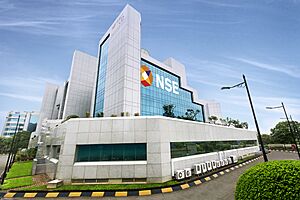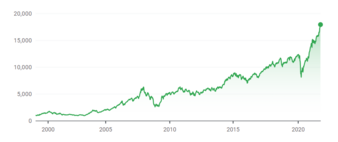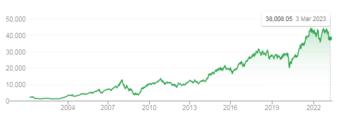National Stock Exchange of India facts for kids
| National Stock Exchange of India | |
|---|---|
Quick facts for kids National Stock Exchange of India (NSE) logo.svg |
|
| IT7A2275 copy (cropped).jpg | |
| Type | Stock exchange |
| Location | [[Mumbai, Maharashtra]], India |
| Founded | 1992 |
| Owner | Various group of domestic and global financial institutions, public and privately owned entities and individuals |
| Key people |
|
| Currency | Indian rupee (₹) |
| No. of listings | 2,190 (December 2023) |
| MarketCap | ₹334.7 trillion (US$5.7 trillion) (December 2023) |
| Indexes |
|

National Stock Exchange of India Limited (NSE) is one of the leading stock exchanges in India, based in Mumbai. NSE is under the ownership of various financial institutions such as banks and insurance companies. It is the world's largest derivatives exchange by number of contracts traded and the third largest in cash equities by number of trades for the calendar year 2022. It is the 7th largest stock exchange in the world by total market capitalization, as of January 2024. NSE's flagship index, the NIFTY 50, a 50 stock index is used extensively by investors in India and around the world as a barometer of the Indian capital market. The NIFTY 50 index was launched in 1996 by NSE.
Contents
History
National Stock Exchange was incorporated in the year 1993 to bring about transparency in the Indian equity markets. NSE was set up at the behest of the Government of India, based on the recommendations laid out by the Pherwani committee in 1991 and the blueprint was prepared by a team of five members (Ravi Narain, Raghavan Puthran, K Kumar, Chitra Sankaran and Ashishkumar Chauhan) along with R H Patil and SS Nadkarni who were deputed by IDBI in 1992. Instead of trading memberships being confined to a group of brokers, NSE ensured that anyone who was qualified, experienced, and met the minimum financial requirements was allowed to trade.
NSE commenced operations on 30 June 1993 starting with the wholesale debt market (WDM) segment and equities segment on 3 November 1994 . It was the first exchange in India to introduce an electronic trading facility. Within one year of the start of its operations, the daily turnover on NSE exceeded that of the BSE.
Operations in the derivatives segment commenced on 12 June 2000. In August 2008, NSE introduced currency derivatives.
NSE EMERGE
NSE EMERGE is NSE's new initiative for Small and medium-sized enterprises (SME) & Startup companies in India. These companies can get listed on NSE without an Initial public offering (IPO). This platform will help SME's & Startups connect with investors and help them with the raising of funds. In August 2019, the 200th company listed on NSE's SME platform.
Markets
The National Stock Exchange of India Limited (NSE) commenced trading in derivatives with the launch of index futures on 12 June 2000. The futures and options segment of NSE has made a global mark. In the Futures and Options segment, trading in the NIFTY 50 Index, NIFTY IT index, NIFTY Bank Index, NIFTY Next 50 index, and single stock futures are available. Trading in Mini Nifty Futures & Options and Long term Options on NIFTY 50 are also available. The average daily turnover in the F&O Segment of the Exchange during the financial year April 2013 to March 2014 stood at ₹1.52236 trillion (US$26 billion).
On 3 May 2012, the National Stock exchange launched derivative contracts (futures and options) on FTSE 100, the widely tracked index of the UK equity stock market. This was the first of its kind index of the UK equity stock market launched in India. FTSE 100 includes the 100 of largest UK-listed blue-chip companies and has given returns of 17.8 percent on investment over three years. The index constitutes 85.6 per cent of UK's equity market cap.
On 10 January 2013, the National Stock Exchange signed a letter of intent with the Japan Exchange Group, Inc. (JPX) on preparing for the launch of NIFTY 50 Index futures, a representative stock price index of India, on the Osaka Securities Exchange Co., Ltd. (OSE), a subsidiary of JPX.
Moving forward, both parties will make preparations for the listing of yen-denominated NIFTY 50 On 13 May 2013, NSE launched India's first dedicated debt platform to provide a liquid and transparent trading platform for debt-related products.
Market statistics
- Earlier, the Bimal Jalan Committee report estimated that barely 3% of India's population invested in the stock market, as compared to 27% in the United States and 10% in China.
- The Economic Times estimates that as of April 2018, 6 crore (60 million) retail investors had invested their savings in stocks in India, either through direct purchases of equities or through mutual funds.
- Morgan Stanley has noted that the Indian stocks have been through four bear markets in 25 years, or since foreign investors became actively involved with Indian equities. The Economic Times estimate that the Indian stock market sees a bear market on average once every 3 years, similar to the US market. It uses the Nifty 50 index as a reference point and identifies eight 20% drops in the last 25 years.
- According to SEBI, during FY 2022–23, 73% of mutual fund units were redeemed within 2 years of investment. Only investments in 3% of the units continued for more than 5 years.
- Another study conducted by the SEBI, approximately 89% of individual stock traders in the equity Futures & Options (F&O) segment incurred losses during the financial year 2021-22.
- According to the Reserve Bank of India report, mutual funds attracted 6% of household savings in FY2023 and less than 1% went into direct equities. Almost 95% of household savings in India park their money in bank deposits, including fixed deposit, provident fund, PPF, life insurance, and various small savings schemes.
- According to 2019 SEBI report, "more than 95% Indian households prefer to park their money in bank deposits, while less than 10% opt for investing in mutual funds or stocks. The survey, conducted across urban and rural areas of the country, showed that life insurance was second most preferred investment vehicle, followed by precious metals, post office savings and real estate in the top-five."
Stakeholders
The key domestic investors which hold a stake in NSE include Life Insurance Corporation, State Bank of India, India Infoline Limited and Stock Holding Corporation of India Limited. Key global investors include Gagil FDI Limited, GS Strategic Investments Limited, SAIF II SE Investments Mauritius Limited, Aranda Investments (Mauritius) Pte Limited, Veracity Investments Limited, Crown Capital Limited and PI Opportunities Fund I.
Subsidiaries
- NSE Indices Limited
- NSE Clearing Limited
- NSE NSEIT
- NSE Infotech Services Limited
- NSE Cogencis Information Services Ltd
- NSE IFSC Clearing Corporation Limited (NICCL), or simply NSE International Clearing
- NSE IFSC Limited, or simply NSE International Exchange
- NSE Investments Limited
- NSE Data & Analytics
- NSE Academy Limited
Financial literacy
NSE has collaborated with several universities like Gokhale Institute of Politics & Economics (GIPE) - Pune, Bharati Vidyapeeth Deemed University (BVDU) - Pune, Guru Gobind Singh Indraprastha University - Delhi, RV University - Bangalore, the Ravenshaw University of Cuttack and Punjabi University - Patiala, among others to offer MBA and BBA courses. NSE has also provided mock market simulation software called NSE Learn to Trade (NLT) to develop investment, trading, and portfolio management skills among the students. The simulation software is very similar to the software currently being used by the market professionals and helps students to learn how to trade in the markets. NSE also conducts online examinations and awards certification, under its Certification in Financial Markets (NCFM) programs. NSE has set up NSE Academy Limited to further financial literacy.
At present, certifications are available in 46 modules, covering different sectors of financial and capital markets, both at the beginner and advanced levels. The list of various modules can be found at the official site of NSE India. In addition, since August 2009, it has offered a short-term course called NSE Certified Capital Market Professional (NCCMP).
See also
 In Spanish: Bolsa Nacional de Valores de India para niños
In Spanish: Bolsa Nacional de Valores de India para niños
- List of companies listed on the National Stock Exchange of India
- Economy of India
- List of stock exchanges
- Bombay Stock Exchange
- Stock market crashes in India
- List of stock market crashes and bear markets
- Mutual funds in India
- Trading day
- Insider trading
- Risk management
- Financial risk management
- Market manipulation
- Muhurat trading
- Clause 49
- Securities and Exchange Board of India




